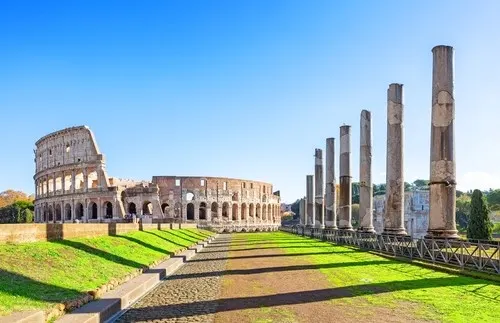The Flavian Dynasty might not be as famous as Julius Caesar or Augustus, but it played a major role in shaping the Roman Empire after a chaotic period. If you’ve ever been to Rome and stood in front of the Colosseum, you’ve already seen one of the Flavian Dynasty’s greatest legacies.
So, who were the Flavians? Let’s break it down.
Table of Contents
From Chaos to Stability
After Emperor Nero’s suicide in 68 AD, Rome plunged into a year of civil war known as the Year of the Four Emperors. It was a power struggle that left the empire unstable and leaderless. Out of that mess rose Vespasian, a seasoned general who had been fighting in Judea. He managed to return to Rome, gain the support of the army, and restore order. Thus, the Flavian Dynasty was born.
Meet the Flavians
The Flavian Dynasty was made up of three emperors:
- Vespasian (ruled 69–79 AD)
- Titus (ruled 79–81 AD)
- Domitian (ruled 81–96 AD)
These three weren’t from Rome’s elite noble families like the earlier emperors. The Flavians came from a humble background in central Italy, making their rise to power even more impressive.
Also read: Best Time to Climb Yala Peak: Weather, Views and Safety
Vespasian: The Rebuilder
Vespasian’s reign focused on rebuilding the empire—literally and figuratively. After years of chaos, he restored financial stability and strengthened the army. But perhaps his most iconic decision was to begin construction of the Colosseum, originally called the Flavian Amphitheatre. Built on the ruins of Nero’s extravagant palace, the Colosseum was a gift to the Roman people—symbolizing a return to traditional values and public entertainment.
He also imposed fairer taxation and cracked down on corruption. Vespasian had a dry sense of humor and famously taxed even public urinals—leading to the Roman saying, “money doesn’t stink.”
Titus: The People’s Emperor
Titus was Vespasian’s son and had a very short reign, but he’s remembered fondly by historians. Before becoming emperor, he had earned a reputation as a military commander, especially in Judea, where he oversaw the destruction of Jerusalem in 70 AD—a significant (and brutal) moment in Roman and Jewish history.
As emperor, he dealt with two massive disasters: the eruption of Mount Vesuvius in 79 AD and a fire in Rome. He responded with generosity and speed, which won him the people’s admiration. He also completed the Colosseum, opening it with 100 days of gladiatorial games and mock sea battles. The people loved him, and he became known as one of Rome’s “good emperors.”
Domitian: A Complex Legacy
The last Flavian, Domitian, is a more controversial figure. His rule was longer than his father’s and brother’s combined, but his leadership style was more authoritarian. He emphasized strong central control, improved the empire’s defenses, and boosted the economy.
Domitian also completed many construction projects, including temples, stadiums, and roads. However, his paranoia led to political purges and executions. The Senate hated him so much that after his assassination in 96 AD, they tried to erase his name from public records—a process called damnatio memoriae.
The End of the Flavian Dynasty
Domitian’s death marked the end of the Flavian Dynasty. But despite its short span, the dynasty had a lasting impact. It brought stability after a time of upheaval, expanded Rome’s reach, and left behind iconic monuments—most notably the Colosseum.
Why the Flavian Dynasty Still Matters
Today, we remember the Flavians not just for their emperors but for what they left behind. Their reign tells a story of rebuilding, resilience, and the power of legacy. If you’re planning a visit to Rome, learning about the Flavian Dynasty adds a new layer of meaning when you walk through the arches of the Colosseum.
